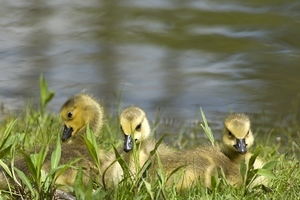|
April 4, 2017
Contact: Holly Vaughn, 313-396-6863
DNR offers advice for those who find a feathered visitor nesting in their yard this spring
 Michigan residents may get a surprise this spring in their gardens, flower boxes or even in the landscaping by their office buildings. Bird nests can be found in some unusual locations. Michigan residents may get a surprise this spring in their gardens, flower boxes or even in the landscaping by their office buildings. Bird nests can be found in some unusual locations.
Ducks nests, particularly mallard nests, seem to appear just about everywhere in the spring. Female mallards often build nests in landscaping, gardens or other locations that people may consider inappropriate. While finding a duck’s nest in an unexpected location may be a surprise, there is no need for concern.
“She will be a very quiet neighbor, and with her cryptic coloration she may go largely unnoticed,” said Holly Vaughn, Department of Natural Resources wildlife communications coordinator. “Leave the duck alone and try to keep dogs, cats and children away from the nest.”
If she is successful and her eggs hatch, the mother duck will lead her ducklings to the nearest body of water, often the day they hatch.
“Don’t worry if you do not live near water, the mother duck knows where to take her ducklings to find it,” said Vaughn.
The female mallard will sit on the nest for about a month prior to the eggs hatching. If the nest fails on its own – something that happens regularly – Vaughn advises to just wish her luck on her next attempt.
Canada geese sometimes build nests near houses or in parks, often near water. Similar to mallards, Canada geese will lead their young to water soon after they hatch. Adult geese can be quite protective of their nests and their goslings and may chase people or pets away by hissing and running or flying toward the intruder. If possible, try to avoid the area. If this is not possible, carry an umbrella and gently scare the bird away.
Those fortunate enough to have a bird’s nest built in their yard, in a tree or on the ground may have noticed that the baby birds are starting to outgrow their nests. Baby birds learn to fly through trial and error. They may feel they are ready to fly, but their flight feathers might not have fully grown in yet. It is common to find baby birds on the ground after an attempt to fly. If this is the case, please do not touch them. Their parents will continue to take care of them, even when they are on the ground.
Touching a baby bird will not cause the adults to abandon it; however, if you move a baby bird, the parents may be unable to find and care for it. It is better to leave the baby bird alone to be raised by its parents.
In the event that you find a chick on the ground that is sparsely feathered, it may have accidentally fallen from the nest before it is ready to fledge (learn to fly). If you know where the nest is, you can put the chick back in the nest ONLY if you can do so safely.
Migratory birds, their nests and their eggs are protected by the federal Migratory Bird Treaty Act and must be left alone. Unless you have a license, taking a baby bird or eggs from the wild is breaking the law.
Only licensed wildlife rehabilitators may possess abandoned or injured wildlife. Unless a person is licensed, it is illegal to possess a live wild animal, including birds, in Michigan.
The only time a baby animal may be removed from the wild is when it is obvious the parent is dead or the animal is injured. A licensed rehabilitator must be contacted before removing an animal from the wild. Rehabilitators must adhere to the law, must have gone through training on proper handling of injured or abandoned wild animals, and will work to return the animal to the wild, where it will have the best chance for survival.
A list of licensed rehabilitators can be found by visiting mi.gov/wildlife or by calling a local DNR office.
/Note to editors: An accompanying photo is available below for download. A suggested caption follows.
Goslings are a common sight in Michigan in the spring./
The Michigan Department of Natural Resources is committed to the conservation, protection, management, use and enjoyment of the state’s natural and cultural resources for current and future generations. For more information, go to www.michigan.gov/dnr.
|

 Michigan residents may get a surprise this spring in their gardens, flower boxes or even in the landscaping by their office buildings. Bird nests can be found in some unusual locations.
Michigan residents may get a surprise this spring in their gardens, flower boxes or even in the landscaping by their office buildings. Bird nests can be found in some unusual locations.




